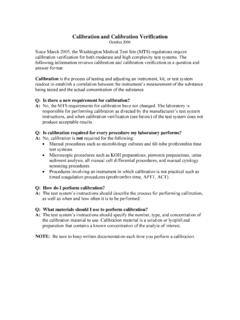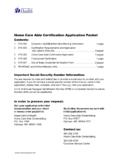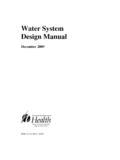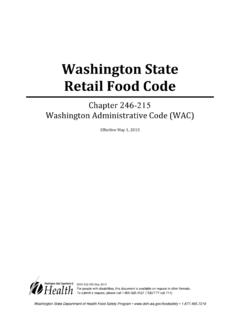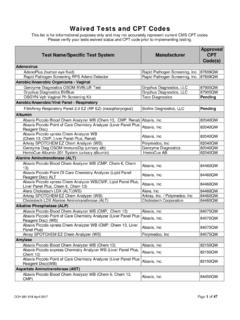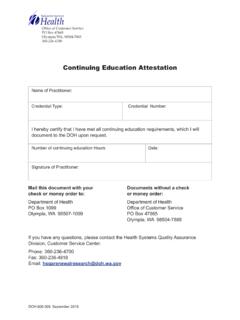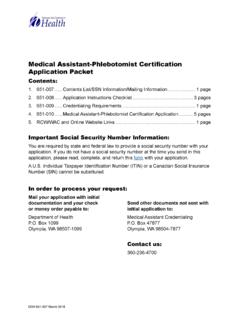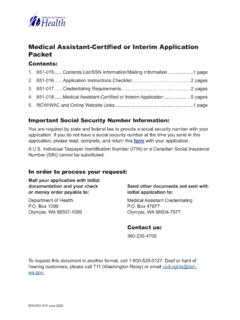Transcription of Adult Tuberculosis Risk Assessment
1 Page | 1 Adapted from the California Risk Assessment Tool and User Guide. For people with disabilities, this document is available on request in other fTo submit a request, please call 1-800-525-0127 (TDD/TTY call 711). DOH 343-144 March 2019 Adult Tuberculosis Risk Assessment Use this tool to identify asymptomatic adults for latent TB infection (LTBI) testing. Do not repeat testing unless there are new risk factors since last test. Do not treat for LTBI until active TB disease has been excluded:For patients with TB symptoms or an abnormal chest x-ray consistent with active TB disease, further evaluation may be needed such as: sputum AFB smears, cultures and nucleic acid amplification testing. A negative tuberculin skin test or interferon gamma release assay does not rule out active TB disease. None; no TB testing is indicated at this the Adult TB Risk Assessment User Guide (pages 2-3) for more information about using this tool.
2 LTBI testing is recommended if any of the three boxes below are checked. Born, live, or travel in a country with an elevated TB rate for at least one month. The duration of at least one consecutive month to trigger testing is intended to identify travel most likely toinvolve TB exposure. Includes any country other than the United States, Canada, Australia, New Zealand, or a country in western ornorthern Europe. If resources require prioritization within this group, prioritize patients with at least one medical risk for progression(see Adult TB Risk Assessment User Guide for this list). Interferon Gamma Release Assay is preferred over Tuberculin Skin Test for persons > 2 years old. Immunosuppression, current or infection, organ transplant recipient, treated with TNF-alpha antagonist ( , infliximab, etanercept, others), steroids (equivalent of prednisone 15 mg/day for 1 month) or other immunosuppressive medication.
3 Close contact to someone with infectious TB disease during lifetime. Treat for LTBI, if LTBI test result is positive and active TB disease is ruled out. Provider: Assessment Date: Patient Name: Date of Birth: (Place sticker here if applicable) Page | 2 Adapted from the California Risk Assessment Tool and User Guide. For people with disabilities, this document is available on request in other fTo submit a request, please call 1-800-525-0127 (TDD/TTY call 711). DOH 343-144 March 2019 Adult TB Risk Assessment User Guide Avoid testing persons at low risk Routine testing of low risk populations is not recommended and may result in unnecessary evaluations and treatment because of falsely positive test results. Prioritize persons with risks for progression If health system resources do not allow for testing of all persons who are born, traveled, or have lived in a country with an elevated TB rate for at least one month, prioritize patients with at least one of the following medical risks for progression: diabetes mellitus smoker within the last year end stage renal disease leukemia or lymphoma silicosis cancer of head or neck intestinal bypass/gastrectomy chronic malabsorption body mass index 20 history of chest x-ray findings suggestive of previous orinactive TB (no prior treatment).
4 Includes fibrosis ornon-calcified nodules, but does not include solitarycalcified nodule or isolated pleural thickening. Inaddition to LTBI testing, evaluate for active TB immunosuppression does increase the risk of disease progression, it does not increase the risk of TB exposure. United States Preventive Services Task Force (USPSTF) The USPSTF has recommended testing persons born-in or former residents of a country with an elevated Tuberculosis rate and persons who live in or have lived in high-risk congregate settings such as homeless shelters and correctional facilities. Because the increased risk of exposure to TB in congregate settings varies substantially by facility and local health jurisdiction, clinicians are encouraged to follow local recommendations when considering testing among persons from these congregate settings. The USPSTF did not review data supporting testing among close contacts to persons with infectious TB or among persons who are immunosuppressed because these persons are recommended to be screened by public health programs or by clinical standard of care.
5 Screening Recommendations are available on the USPSTF website. Local recommendations Local TB control programs and clinics can customize this risk Assessment according to local recommendations. Providers should check with local TB control programs for more information. Local health jurisdictions contact information can be found on the online at: Mandated testing and other risk factors Several risk factors for TB that have been used to select patients for TB screening historically or in mandated programs are not included among the components of this risk Assessment . This is purposeful in order to focus testing on patients at highest risk. However, certain populations may be mandated for testing by statute, regulation, or policy. This risk Assessment does not supersede any mandated testing. Examples of these populations include: healthcare workers, residents or employees of correctional institutions, substance abuse treatment facilities, homeless shelters, and others.
6 Age as a factor Age (among adults ) is not considered in this risk Assessment . However, younger adults have more years of expected life during which progression from latent infection to active TB disease could develop. Children This risk Assessment tool is intended for adults . A risk Assessment tool, created for use in children, is available here: Foreign travel Travel to countries with an elevated TB rate may be a risk for TB exposure in certain circumstances ( extended duration, likely contact with an infectious TB patient, high prevalence of TB in travel location, non-tourist travel). The duration of at least one consecutive month to trigger testing is intended to identify travel most likely to involve TB exposure. TB screening tests can be falsely negative within eight weeks after exposure, so are best obtained eight weeks after the last exposure, or return from travel. Page | 3 Adapted from the California Risk Assessment Tool and User Guide.
7 For people with disabilities, this document is available on request in other fTo submit a request, please call 1-800-525-0127 (TDD/TTY call 711). DOH 343-144 March 2019 Adult TB Risk Assessment User Guide continuedWhen to repeat a test Re-testing should only be done in persons who previously tested negative, and have new risk factors since the last Assessment . In general, this would include new close contact with an infectious TB case or new immunosuppression, but could also include foreign travel in certain circumstances. When to repeat a risk Assessment The risk Assessment should be administered at least once. Persons can be screened for new risk factors at subsequent preventive health visits. IGRA preference in BCG vaccinated Because IGRA has increased specificity for TB infection in persons vaccinated with BCG, IGRA is preferred over the TST in these persons.
8 Most persons born outside the United States have been vaccinated with BCG. Previous or inactive Tuberculosis Chest radiograph findings consistent with previous or inactive TB include fibrosis or non-calcified nodules, but do not include a solitary calcified nodule or isolated pleural thickening. Persons with a previous chest radiograph showing findings consistent with previous or inactive TB should be tested for LTBI. In addition to LTBI testing, evaluate for active TB disease. Negative test for LTBI does not rule out active TB disease It is important to remember that a negative TST or IGRA result does not rule out active TB disease. Any suspicion for active TB disease or extensive exposure to TB should prompt an evaluation for active TB disease, including physical exam, symptom review, and 2-view chest x-ray. Symptoms that should trigger evaluation for active TB disease Patients with any of the following symptoms that are otherwise unexplained should be evaluated for active TB disease: cough for more than 2-3 weeks, fevers, night sweats, weight loss, hemoptysis.
9 Most patients with LTBI should be treated Most patients with LTBI should be treated Persons with risk factors who test positive for LTBI should generally be treated once active TB disease has been ruled out with a physical exam, chest radiograph and, if indicated, sputum smears, cultures, and nucleic acid amplification testing (NAAT). However, clinicians should not feel compelled to treat persons who have no risk factors but have a positive test for helpful online resource to assess an Adult s risk of progression to disease based on screening results and risk factors is: Emphasis on short course for treatment of LTBI Shorter regimens for treating latent TB infection have been shown to be as effective as 9 months of isoniazid, and are more likely to be completed.
10 Use of these shorter regimens is preferred in most patients. Drug-drug interactions and contact to drug resistant TB are typical reasons these regimens cannot be used. Shorter duration LTBI treatment regimens Medication* Frequency Duration Rifampin Daily 4 months Isoniazid + rifapentine Weekly 12 weeks * 11-12 doses in 16 weeks required for more information, refer to LTBI Treatment Guidance in Washington State and one-page LTBI Treatment Quick Reference Sheet found online at: Have questions or need consultation on a LTBI or TB patient? TB ECHO is a weekly videoconference meeting for healthcare professionals to get TB education, consultation, and mentoring. Learn more at: Patient refusal of recommended LTBI treatment Refusal should be documented. Recommendations for treatment should be made at future encounters with medical services.
